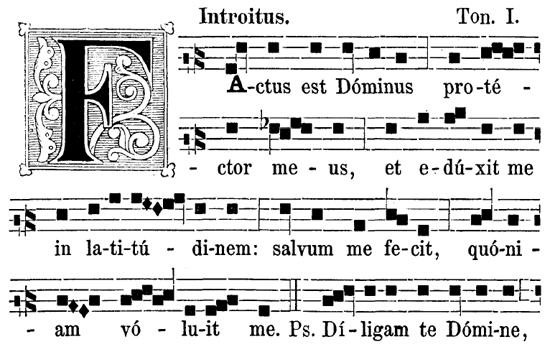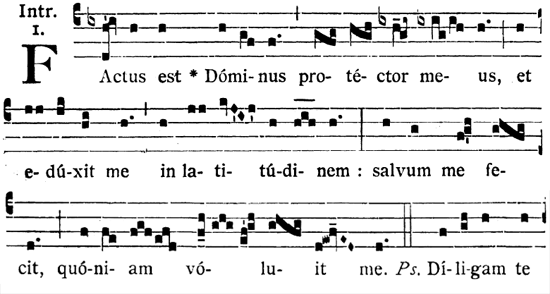Ratisbon! It's in!
-
yipee!!! Ratisbon/Neo-Medici/Medicean Graduale just arrived in my in box.
No time today I don't think but I just wanted to tell you so that you can be crazed with anticipation. -
Almost done
Going to upload here and leave it for a day before posting on NLM. The hope is to avoid another server crash. -
ok, here we go.
For anyone who has never seen this before, you will first note that it is not as beautiful as the Vatican/Solesmes editions. It's where we came from! -
Hopefully I'm first to download it!
-
Thanks, Jeffrey. This is too cool.
-
This is posted at NLM
________This is a very interesting book to have online: The 1871 Ratisbone edition of the Graduale Romanum. It has been entirely superseded by the modern Graduale Romanum, beginning in 1908 and following. Still, it is extremely interesting to have this available.
To see what was behind this edition, which prevailed for hundreds of years Trent, we turn to Johannes Berchmans Goeschl from the Summer issue of Sacred Music. He explains that the post-Trent reform efforts were driven by artistic issues rather than a concern for authenticity.In the name of primacy of the text, the “reformers” wanted to purify the Gregorian chant of all offensive “barbarisms.” By “barbarism” they especially meant that in the inherited Gregorian chant, neume groups with several notes, or even melismas, are oftentimes placed on an unaccented syllable, while the accented syllables are oftentimes treated with only a single note. One aimed especially at the avoidance of melismas on short unaccented syllables immediately before the text accent, and also the simplification of concluding melismas.
Clarity and uniformity were to be achieved in the realm of modality, especially by ensuring that each chant begins with either the first scale degree or the reciting tone of the mode. In order to take into account modern sensibilities, many B-naturals were lowered to B-flat, and this often in modes for which the B-natural is essential to the character.
The author goes further to explains that "The melodic line of unison Gregorian
chant in its most complete development in the Mass propers depends essentially upon ornamentation, even on unaccented syllables. This ornamentation need not be to the disadvantage of the text, but rather, it can bestow an all the more heightened profile upon the text. To have missed this was one of the most grave of the false interpretations of the authors of the Medici edition."
He provide Factus est Dominus, Introit for the Second Sunday after Pentecost, as an example.
1871:
1961 (Solesmes)
It is striking and, really, quite astounding. What is the lesson here? There are many of course but it does point to the dangers of focus exclusively on text at the expense of the reality that chant is, after all, music and art; text and music work together, and an exclusively emphasis on one at the expense of the other can lead to error. In addition, there is a broader lesson that we must be careful in following the "style of our times" rather than the accumulated wisdom of the ages. Tradition is much "smarter" and more knowledgeable than any single generation.
A special thank you to Matthew Williams for his donation of the book for scanning! -
Fr. Thompson offers an interesting point of view here.The two types of chant are indeed very different, but I suspect that some choirs might find the Medicean music easier to learn and the Latin easier to understand when sung. This is not to say that it is better. Seventeenth-century polyphony is very different from fifteenth-century and both have their place.
I am inclined to think that Early modern chant has an (and admittedly secondary) place in our repertoire of sacred music. In fact, the stylistic emphasis on accented syllables produces a chant that is more like measured music; the favoring of the flat gives a F-major feel to many pieces.
I suspect that in performance this might blend easier with polyphony than the medieval version of the music does--and at times the shift from one polyphony to chant can seem very abrupt.
I would love to hear what the reactions are if any choirs experiment with this music....
There is no rule about what music the propers must be sung to, although the official gradual is that reformed by Solesmes. We have just had a conversation about the Byrd Propers. And as you might know some choirs at EF celebrations recto-tone the propers or do them in false burdoon because they have not yet learned the propers in chant.
So just as there is nothing to prevent the singing of the Ordinary to any suitable music, so there is nothing to prevent the singing of the propers using this music.
That opinion startled me since I had never heard anyone make these points. What do you think? -
With the greatest respect to Fr. Thompson, I don't think this edition has any place at all in the repertoire, as interesting as it is for historical reference. Its development was ideologically driven rather than organic. It therefore deserves a place on the same shelf as other regrettable liturgical developments: the Quinonez breviary, the Urban VIII Office hymns, iconoclasm (ancient and modern), and the politically-corrected, bowdlerized versions of beloved hymns that plague contemporary hymnals.
Going back to Jeffrey's comment about lessons to be drawn from history: It's widely acknowledged today that the Graduale we know and love isn't 100% perfect by its compilers' own standards. (That's not surprising--what's astonishing is how close to perfection they came.) If a new Vatican edition were to be issued with melodic corrections and improved notation, would we embrace it? Or would we cling to what we know the way the Caecilians clung to the Medici edition? -
Robert, you raise an interesting question about whether a new edition would be embraced. There are two facts of reality that now bear on this issue: 1) Chant is sung in a tiny minority of parishes today, and 2) most every monastery and convent in the world that sings Latin chant sings the current books with old Solesmes rhythm. So this makes me wonder whether there would be any point to introducing yet another Graduale now. Perhaps we need 100 years or so to restore and improve the status quo ante.
-
Actually, at my parish we perform chant from the original paleography influenced by the semiological research of Dom Cardine, for the kind of "nuanced" performance described by Richard Crocker in An Introduction to Gregorian Chant. Of course, in order to do this, one has to have access to scholarly editions of the earliest manuscripts:
So I vote for a new edition. -
hmmmm. This is starting to sound like the tower of babel! IMHO, there will always be many styles and schools of the various eras of chant, hymnody, polyphony, etc. we may all want to put it neatly and squarely in a single box (book), but i don't think we will ever see that happen this side of heaven.
-
As of late I have been reading about the two opposing editions during that era, Ratisbonae and the Solesmes, and how the history played out. I think it is interesting to note that there is a constant struggle between the "authentically pure" forms which try to be faithful to historical practice and those that attempt to make chant more widely utilized and loved. If you are a monk in Solesmes, we know which flavor you will prefer to sing. If you are the DM in an American parish just starting out in chant, well, the easier edition could be a good solution.
I have run into this tension with other styles of music, especially those who are Baroque purists. Must be played on authentic instruments, with 'authentic' ornamentation, etc. etc.
In the end, what is MOST important is that the music is performed. If we put our nose up in the air every time a different version is sung, we are defeating our own cause, don't you think? In my way of thinking, aren't they ALL variations of true Roman Chant?
An illustration.
I lived in Baltimore most of my life. The Basilica there was simply stunning. In 2005 it underwent a massive restoration (supposedly) according to the original plans of the architect, Benjamin Latrobe. It was torn down to the dirt inside and out. Benjamin has been dead for a long time, but the plan was to "restore" the Basilica to the exact intention of the architect. Well, this they (thought) they did (maybe). They removed all the stained-glass windows, tore out the benches, etc., etc, all in the name of authenticity. Meanwhile, the beautiful and wonderful history of the devotion of many to the parish were also ripped out and thrown in the trash.
Similarly, the original plan of God for each of our lives was probably jettisoned in some way by each of us all early on in our lives; either by us, our guardians, our priests, our friends, etc. But God doesn't look at us that way. He treasures all the devotion and effort we put into our lives, and he LOVES our imperfect state just the same. He doesn't come back to us at age 50 and say, "Well you had a chance to be what I intended, and you didn't get it right, so I am going to remake you according to my original thoughts." That's hogwash.
Sometimes I give my wife flowers, sometimes jewels, sometimes just a kiss. She treasures one just as much as the other.
God also treasures ALL the imperfect things of his church, especially when they are done out of love and devotion to him. They are no less perfect than his 'perfect plan'. This is the mystery of his love, and we should treat each other with the same regard. That also goes for the Ratisbonae edition.
-
It reminds me what I was trying to do earlier when I was starting to get sung Masses going and wanted something a little better than straight psalm tones. I'd go through and keep the notes I could manage and drop the more complicated bits. It took a while, and maybe would have been better to spend the time learning the proper thing... But when you're not up to singing solo, have no one handy to teach you and the one thing you can do is type up chant with gregorio...
If I have someone to go through the chant with me I can "get" it and try teaching it on, but taking something unfamiliar out of the Liber Usualis and try make it flow - it's a bit miss and miss still.
Thanks for putting these up.
Welcome to the MusicaSacra Forum!
To participate in the discussions on Catholic church music, sign in or register as a forum member, The forum is a project of the Church Music Association of America.
Categories
- All Discussions21,164
- General Music Discussion8,241
- Job Openings204
- Management of Music Programs850
- Choral Matters533
- Church Documents and Rubrics526
- CMAA Notes304
- Events720
- For Newcomers: Read First26
- Sacred Polyphony547
- Hymnody872
- Gregorian Chant: General2,703
- ↳ Graduale Romanum and Liber Usualis369
- ↳ Graduale Simplex60
- ↳ Semiology63
- Vernacular Plainsong696
- Anglican Use and Anglican Chant68
- Organ, Other Instruments and Repertoire435
- New Composition/Works in Progress1,295
- Recordings234
- Music for Hispanic Ministry159
- Music Education: Children211
- Music Education: General222
- News Items245
- Positions Wanted2
- General Discussion: Catholicism740
- Amusements177
- General Discussion1,035
- Opinions119



